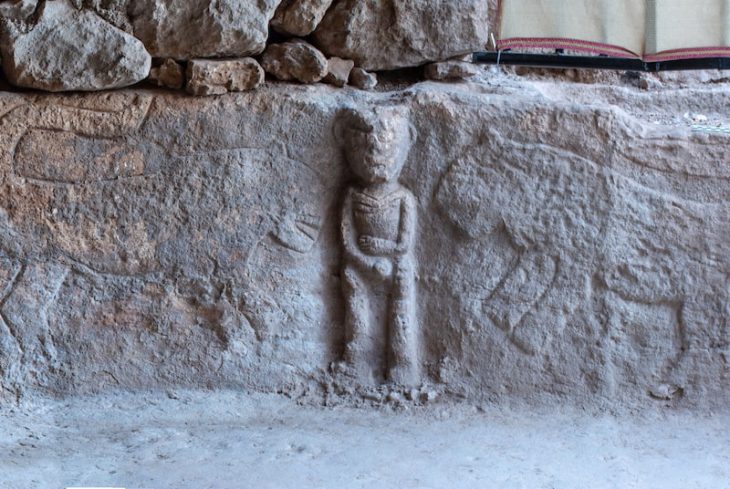Archaeologists in southeastern Turkey have unearthed a captivating discovery at the Sayburç archaeological site – a detailed relief carving dating back to the Pre-Pottery Neolithic period, estimated to be around 11,000 years old. This remarkable find, located in one of the “Taş Tepeler” (meaning “stone mounds”) near Şanlıurfa, sheds light on the symbolism and belief systems of our earliest ancestors.
The intricate carving depicts a scene involving five figures: two humans, two leopards, and a bull. The central human figure, a male, stands out for his pose – he holds his phallus with one hand while the other rests on his stomach. Interestingly, a triangular symbol adorns his neck, a recurring motif seen in other Neolithic human depictions from the region. Flanking this central figure are two identical leopards, their mouths agape and tails raised, seemingly poised to pounce.
The scene takes an unexpected turn on the western side. Here, another male figure, depicted in profile, stands facing a bull with impressive horns. This second man holds a snake upside down in his raised left arm, while his right hand remains unseen. Adding to the intrigue, this figure appears to have six fingers on his left hand.
The presence of phalluses in such an ancient artwork is particularly noteworthy. While phallus representations have been found throughout history and across cultures, the Sayburç carving offers one of the earliest examples. Dating back even further are phallus paintings found in the Cosquer Cave near Marseille, France, estimated to be 27,000-19,000 years old.
The exact meaning behind the Sayburç relief remains open to interpretation. Some archaeologists believe the phallus may symbolize fertility or procreation, while others suggest it could represent dominance or power. The inclusion of leopards, often associated with hunting and prowess, and the enigmatic figure holding the snake further add to the complexity of the scene.
The juxtaposition of these figures – the central male with the phallus, the flanking leopards, and the snake-wielding man confronting the bull – suggests a narrative of some kind. Perhaps it depicts a ritualistic scene, a story about human interaction with the natural world, or even a creation myth. The lack of clear facial expressions makes deciphering the emotions and intentions of the figures even more challenging.
The Sayburç relief, with its rich symbolism and captivating imagery, offers a valuable window into the minds of our Neolithic ancestors. It compels us to consider their belief systems, their relationship with the animal world, and the stories they sought to tell through art. As further analysis and interpretation are undertaken, this remarkable discovery promises to deepen our understanding of this pivotal period in human history.
